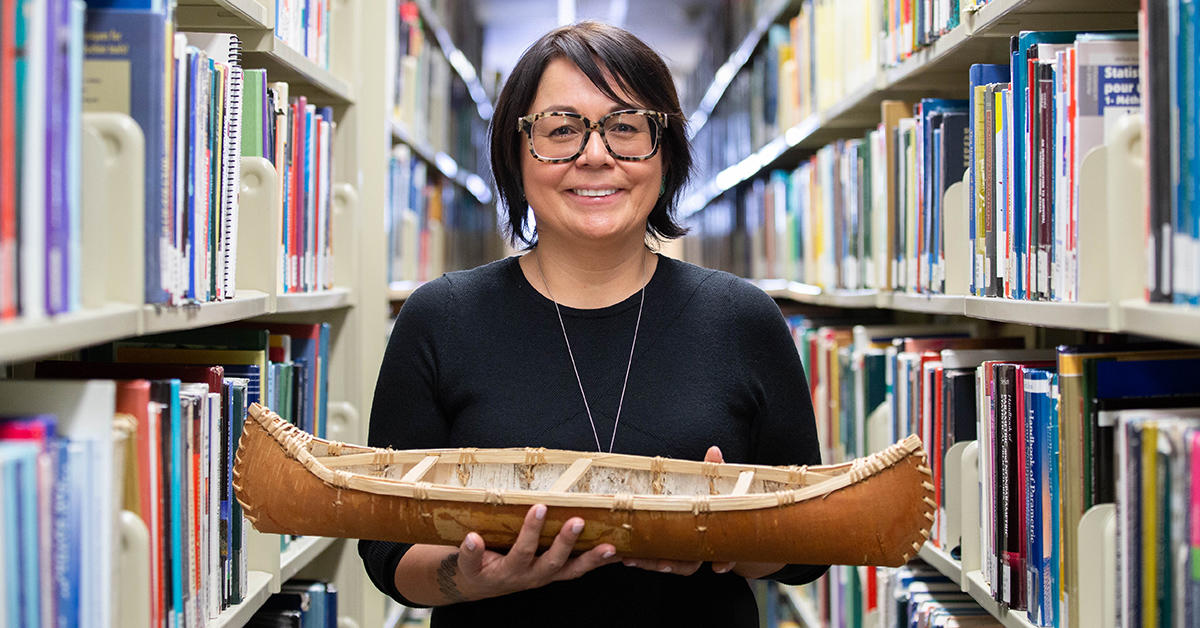In 2015, the Truth and Reconciliation Commission presented 94 calls to action to build bridges between Indigenous peoples and other Canadians. Law schools were asked to implement mandatory courses on cross-cultural, dispute resolution, human rights and anti-racism skills. This year, such a course was given by Eva Ottawa, an assistant professor in the Civil Law Section and former grand chief of the Atikamekw Nation, who agreed to answer our questions.
Q: Why is it important to offer a mandatory introduction to Indigenous law course in the Faculty of Law starting in first year?
A: We must all commit to reconciliation for the well-being of the next generation. We must make our students aware of the consequences of the residential schools, of their history and today’s realities. Thanks to this mandatory course at the outset of their legal education, students are able to learn that Canada is a pluralistic state and not just bijural. Students must also know that we’re on ancestral Indigenous territories and that First Nations have a different idea of the relationship with land or territory. It’s important to make our future legal professionals aware of these realities so that they can be meaningfully engaged in reconciliation.
Q: How does this course fit in with efforts towards reconciliation with first peoples?
A: The Indian Act was and still is an instrument of colonization. For many years, it prohibited use of Indigenous languages, as well as ceremonies, for example. The avowed goal of this law was the assimilation of Indigenous peoples. Today, law schools have a key role to play in increasing the visibility, recognition and knowledge of Indigenous legal traditions. This intensive course increases the space in the Civil Law Section given to Indigenous legal cultures, to raise student interest in learning more about these legal traditions, to share the Indigenous view of “law” and to spread knowledge of Indigenous law long suppressed by the state, indeed, hidden or made invisible by law schools. It also enables students to better understand Indigenous perspectives.
Q: Where does one start when studying an age-old oral legal tradition?
A: With the Atikamekw Nehirowisiwok, as with Indigenous peoples in general, legal knowledge is transmitted orally through atisokana. There are kitci atisokana, the collection of creation stories that contain the sacred teachings. Kitci atisokana are told in a specific context at a precise time. Then there are atisokana (stories, fables and legends). There are many, some dealing with animals and other creatures. Atisokana hold meaning, a vision of the world or a moral. They contain teachings, principles, obligations or conventions. Atisokana contain the memory of our ancestors, which has been handed down from generation to generation. Our families and our elders have an important, unique role in passing on and teaching legal traditions. The teachings of kitci atisokana and atisokana are our “sacred law.” Each person is encouraged to carry these teachings inside them.
Q: Do you have examples of legal traditions that were discussed in the course?
A: The last day, I presented preliminary results of my empirical approach with the Atikamekw Nehirowisiwok of Manawan to document the movement of children, their traditional awactenmakanicic e opikihakaniwitc system being committed to children’s autonomy. I was inspired by the intelligibility schema of the Chaire de recherche du Canada sur la diversité juridique et les peuples autochtones and Professor Ghislain Otis. Their work has brought out five fundamental elements found in any legal system, namely, values, principles, rules, actors and processes. This comparative approach has allowed us to look at civil law, with its state-based full adoption regime, and the traditional system, and then locate areas that potentially conflict with co-existence.
Q: How did Indigenous communities respond to this opportunity to present their view of the world and of justice?
A: Generosity, listening, respect, openness and mutual assistance are important values passed on through atisokana. When I sent invitations, the response was practically instantaneous. I explained the course context as it related to the Truth and Reconciliation Commission’s 28th call to action. I also told them of the importance for first-year law students to hear speakers’ reality, challenges and knowledge. In taking on the coordination for the first year, I wanted to present legal traditions connected to my origins, the Atikamekw Nehirowisiwok. As well, Okimaw Gilbert Whiteduck of Kitigan Zibi offered us words of welcome to his ancestral territory, sharing teachings related to use of sage, the drum and the eagle’s feather.
Q: How was the course received by students and what did they take away from these teachings?
From reading students’ personal reflections, what speakers shared these two days was much appreciated. As well, during the presentations, some students said that it would be important to share atisokana in schools across Canada. Others mentioned that they’re interested in learning more about atisokana. So this course has led to more openness towards Indigenous legal traditions. It’s a start, and being able to listen to and read these personal reflections gives me hope. We must commit ourselves to continuing and doing more.
*With assistance from Florence Robert, research assistant, Civil Law Section
